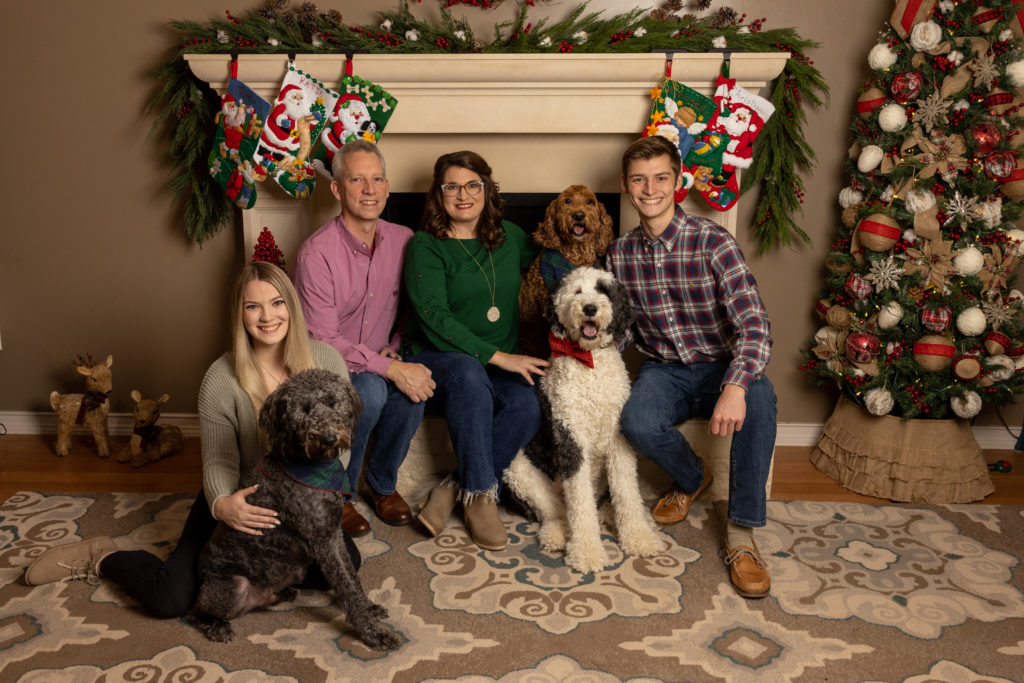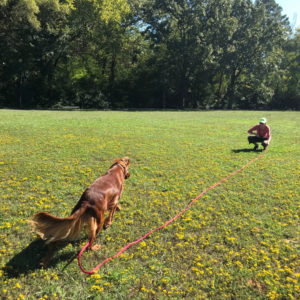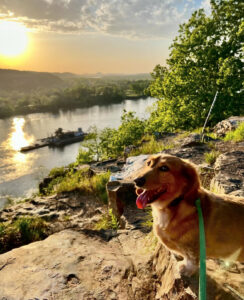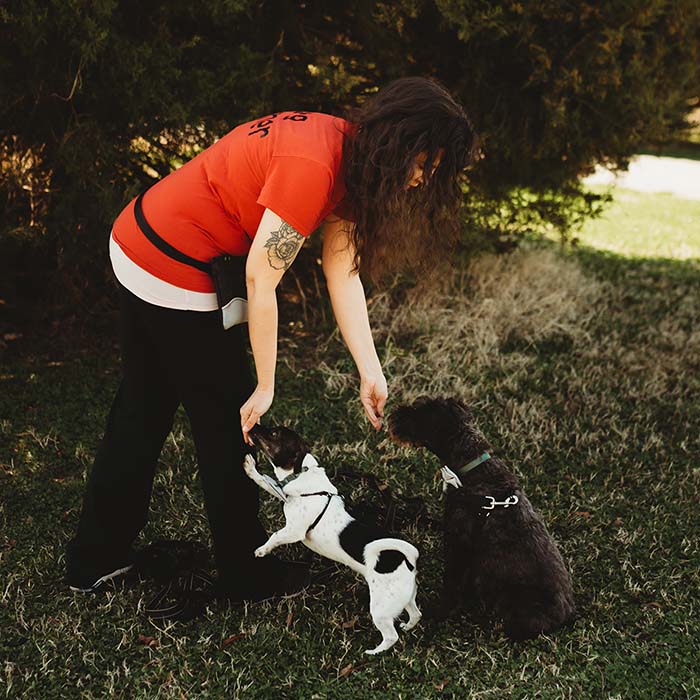“We’d Love to Have You”: Therapy Animal Registration with Katie Kasten of Pet Partners
Podcast Transcript
[Intro]
Katie: Lowe’s probably will get mad if I keep mentioning them. They’ll end up with all these dogs in there. [Laughs] But I would put a ‘do not pet’ vest on him, take my treat pouch with me, and we’d go on Friday nights like an hour before they’d close. Because that is the least populated time in Lowe’s–8:30 on a Friday night–and we would literally walk in walk up and down two aisles and back out.
[Music]
Elizabeth Silverstein: Hi, welcome back to Telltail Dog the Podcast. I’m your host, certified dog trainer Elizabeth Silverstein, and I have with me today, Katie Kasten, who is the Strategic Partnerships Coordinator for Pet Partners. Hi Katie, how are you?
Katie Kasten: I’m good. How are you today, Elizabeth?
Elizabeth: I’m doing well. Thanks so much for coming on. I know you mentioned that it is National Therapy Animal Day on April 30, so it sounds like a perfect timing to have you on and discuss all things related to therapy animals.
Katie: Yeah. Well, thank you so much for having me and I am really excited to share about Pet Partners today.
Elizabeth: Yes, and I’m excited for you to be here. So, Pet Partners has a proclamation from Pulaski County proclaiming April 30 as National Therapy Animal Day. What does that mean for Arkansas Pet Partners?
Katie: Yeah. So, we have asked that to be proclaimed because we really do want to honor the work that therapy animals are doing in our local community. We have a great active group here in central Arkansas. Pet Partners is [a] national organization with about 8,000 teams across the country, but here in central Arkansas, serving Little Rock, we have about 60 teams. And so, we in Arkansas have a lot of dog teams. There’s also a mini horse team and some rabbit teams, and [we] really wanted to set a day aside throughout the year to celebrate the hard work and the service that they do with their community.
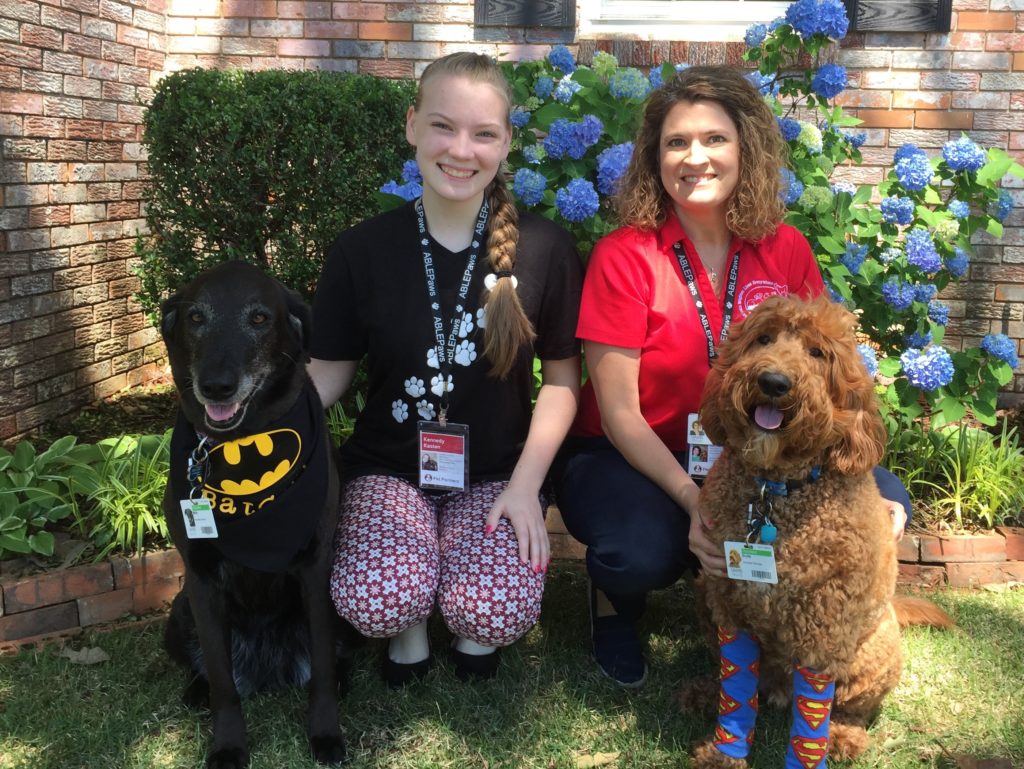
Elizabeth: Yes, and I noticed that [it] is Therapy Animal Day, not Therapy Dog Day. So, you mentioned horses, rabbits.
Katie: Yes.
Elizabeth: What are some other animals that can get certified?
Katie: Yeah, so, Pet Partners registers nine species of animals, and it is: dogs, cats, rabbits, guinea pigs, birds. Let’s see–I should have had it written down in front of me. Equine. That includes both donkeys, horses, miniature horses. Let’s see. Llamas and alpacas. Not sure what number I’m at, but we do have a wide variety of species that we register, so if you have something check out the website and we can see if your animal qualifies.
Katie got almost all of them! She was missing rats and pigs. See more here: Cats, horses, rabbits, pigs, birds, llamas and alpacas, guinea pigs and even rats are eligible for evaluation through the Pet Partners program.
Elizabeth: And you mentioned registered, not certification. So, what is Pet Partners?
Katie: Yeah. So we register, and there is a difference between registering and certifying and there’s, you know, licensing and different types of technical terms. Pet Partners uses the term registered. You do go through a handler’s course or people side of things. We say, ‘The human side of the leash.’ There’s a course you could take in person or online. There’s a handler’s guide, and then an assessment. It’s essentially a test, you know, multiple choice, true-false, kind of thing. Making sure that our handlers that go out there do know the rules and safety of being a handler with their animal and we do training also with being an advocate for their animals when they are on visits. And so all of that goes into the human side of the leash and then there’s an evaluation and we actually register as teams, so both the handler and the animal at that evaluation are being scored separately and it’s their combined score on that evaluation that qualifies them to be registered with Pet Partners.
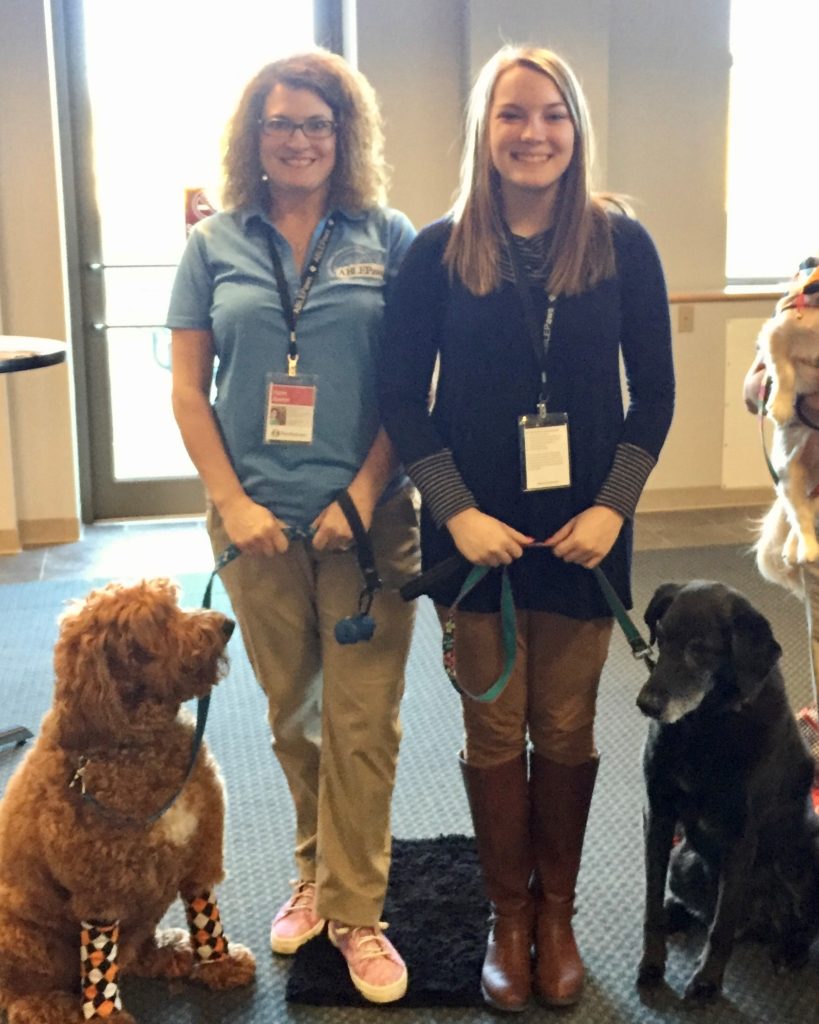
Elizabeth: Do you need to be registered to be a therapy dog?
Katie: There are actually several organizations across the country that register therapy animals. Most register just dogs. Pet Partners is unique in that we register nine full species of animals, but with Pet Partners registration comes some very important things. We have a lot of continuing education for the handlers, and that is a benefit, but probably the most used benefit or the benefit that most facilities want to know about is, once you’re registered with Pet Partners–those registrations last two years–you’re covered under $2 million general liability insurance when you’re on visits as a Pet Partners’ team. So, there are several facilities that will create their own rules and guidelines for visiting inside their facility, but most do require insurance for the teams and that is something that comes with being registered with Pet Partners.
Elizabeth: And I know Pet Partners doesn’t have any breed restrictions. Is that correct?
Katie: We do not, and it’s one of the things that I appreciate about Pet Partners overall, is our diversity. We say we have a diverse group of volunteers serving a diverse group of people with diverse therapy animals. Just like every person that we see is not the same, every animal that goes on visits are not the same. And just as different species of animals have the aptitude for this type of work, different breeds of dogs have that, too. There are some therapy organizations out there that might only register one breed. Like Golden Retrievers are very popular for zoning in on that, but we really do feel that any animal has the–any breed has the capacity to do that, and it’s really in the training, the background, and the aptitude of that animal that comes into play.
Elizabeth: I really appreciate that, because it sounds like it’s very much about the individual or the individual teams, not necessarily what we expect or what we think an animal should be able to do or not.
Katie: Yeah, and I’m on my second therapy animal with Pet Partners, besides being staff, which I’ve been staff with Pet Partners for about three years. I’ve been a handler and a volunteer with Pet Partners for over seven years. And so my first dog was a lab mix, Molly, and she has passed, but is still very dear to my heart. She was a lab who didn’t like water and really did not want to be in it, so she was very different than her breed, and then what people would assume about her. She loved to visit with elderly people and loved to do nursing home visits. And then I have a golden doodle now, Scully, and I always say babies he loves with his whole heart, and he is so sweet and so gentle with babies. And so people will ask, ‘Is one dog better than another, or one breed better than another?’ It’s really dog specific, just as humans are different and we enjoy different activities, dogs enjoy different activities. And I think it’s really important to not make assumptions about species or breed or people and to see what type of work they really like to do.
Elizabeth: I had another trainer on the podcast. Before she became a trainer, she adopted a dog and eight trainers told her this dog would not be a therapy dog and now, it’s like five years in, and this dog has done over a thousand visits and loves it and does really, really well. So I love that it’s about the individual and not so much about–and I think as that’s a very human thing to do. We want to know, right? So, this means this all of the time and that’s just not how life works and not how dogs work and not how people work. Sometimes maybe that is true, but many times it’s not. So we really have to make sure that we’re analyzing the situation and the individual for what they are.
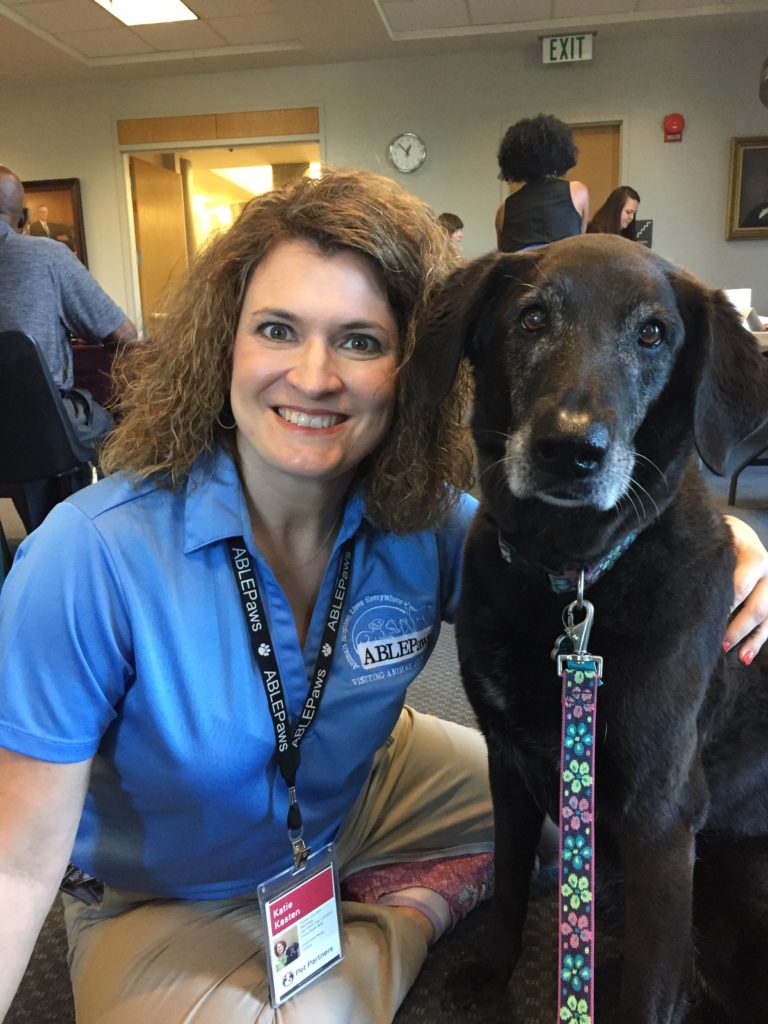
Katie: Yeah, and we at Pet Partners are very strong with our handlers during their training and then with continuing education, that handlers have to be advocates for their animals. They do talk to us in their body language and in how they say things very clearly to us. We need to be perceptive as humans in listening to them. One thing I noticed after I became a handler with Pet Partners, and was handling my dogs in public, is, it actually became very clear to me to read other people when they might be nervous or scared around my animal, and to move my animal away from them or position my animal in a way that wasn’t threatening to them. In the same way our animals tell us when they are scared or nervous, and we need to listen to them as well. And I share this as an example sometimes, but I loved–as a person, I’m kind of outgoing and love to talk about my therapy animal, like today, and when I’m on visits–and I love to go–the Little Rock Airport has a program with therapy dogs. And they’re in there all the time to help travelers with stress and to talk to people while they’re waiting and during delays and such. And I love to go to the airport with Scully. Scully hates the airport. He made it very clear to me by every time we turn the corner and he’d try to head to the exit instead of to where people are. And it became very clear to me that wasn’t a good place for Scully. And so, we are a team when we go out, and it’s really important that I honor his wishes and listen to him with the language he gives me. And I find that when we’re visiting people the same way. If people are nervous or scared, we never force that interaction with them. It’s really important to honor their sense of space and their sense of safety when they’re around our animals as well.
Elizabeth: Katie, how would you define a therapy animal, and what their responsibilities are?
Katie: Yeah. So, when we evaluate for a therapy animal, we do several things. We do the general things that you and I know that you’re familiar with that’s often in the Canine Good Citizen tests. So, sit, stay, come when called, walking on a loose leash. We do all of those types of things. We also do aptitude for visiting in social settings. That might be complex. So we have people arguing in the room. And we see that after they stop arguing, and the animal has seen them arguing, will they still approach them? You know, will they still be friendly and want to visit with them? We have people with walkers, in wheelchairs, medical equipment, visual distractions, noise distractions. It’s not so important that the animal is non-reactive completely, but it’s important that they recover from those situations and are able to continue with social interactions. And we’re looking to see that that animal enjoys doing this. I tried with Molly. It was actually harder with her as her handler to tell what she enjoyed doing. Molly would follow me into a burning building if I asked her to. She was the type of dog where I was like, ‘Molly we got to go in this building. It’s burning.’ And she would have been like, ‘Okay, let’s go. I’m with you.’ Scully is like, ‘I’m gonna sit right here outside. That looks hot, and I’ll be here when you get done.’ [Laughs] He’s a little more expressive with what he doesn’t want to do and so it’s easier for me to advocate for him that way, but we want the animals to enjoy what they’re doing and enjoy the visits. It’s important for both ends of the leash to enjoy that. Because when you’re visiting with someone, if your animal or you don’t want to be there, that comes through to that person. And we’re really there to promote human health and well-being through the human-animal bond and so, it’s important that everyone is comfortable in that situation.
Elizabeth: Yeah, and I love that consideration too. I think sometimes it’s just a very human aspect to be like, ‘Well, I want to do this.’ But our dog is telling us, ‘No.’ I see that a lot when I ask people if I can pet their dog and they’re like, ‘Yes’. [But] the dog’s telling me no, and I’m like, ‘Okay, never mind.’ They’re like, ‘No, it’s fine.’ I’m like, ‘No, your dog’s telling me no thank you.’ So, that can be very subtle, too. So, learning dog body language, and I guess animal body language for the other animals, is so important so that you can have that relationship.
Katie: Yeah. And actually, Pet Partners, for their handlers, offers a canine body language training and workshop, and I think I had been a handler for four or five years when I took that workshop finally and I learned so much, even having done this for a while, and even thinking that I knew what I was doing. Learning those things are so important. I think not just for therapy animal handlers, but for people in general. Like you said, when you are greeting a dog out in public to be able to recognize those signs that that dog is saying, ‘no,’ is really a safety thing for you and for other people in the community. One thing that I love that we do here locally in central Arkansas is a dog safety class, and this is usually done with preschool and kindergarten age kids. The age where it’s really important that they are able to read a few signs for their own safety. So, we always teach kids that you never approach any animal and particularly with dogs, you never approach them if there’s not an owner and a leash. For their own safety. As long as there’s an owner or leash, you can approach and we ask them or teach them to do three things. To ask the owner for permission. ‘May I please pet your dog?’ Just like you said you asked. We teach kids to ask that question. Then we teach kids to fold their fingers in and offer kind of the back of their fist, but with their hand down for the dog to smell and then to reach around the side to pet. And so we explain, just like if you were to greet another person. You don’t walk up to people you meet and stick your hand on the top of their forehead and rub their hair right in their eyes. You don’t want to do that to a dog, either. That’s uncomfortable for a lot of dogs to reach over their heads. So to reach around the side and pet. And so, it is really interesting then to be out in public with Scully somewhere else, and to have a kid come up in and just basically go, ‘May I please pet your dog?’ And then let the dog smell him and reach around, and to see how many kids have picked that up over the years has been really neat.
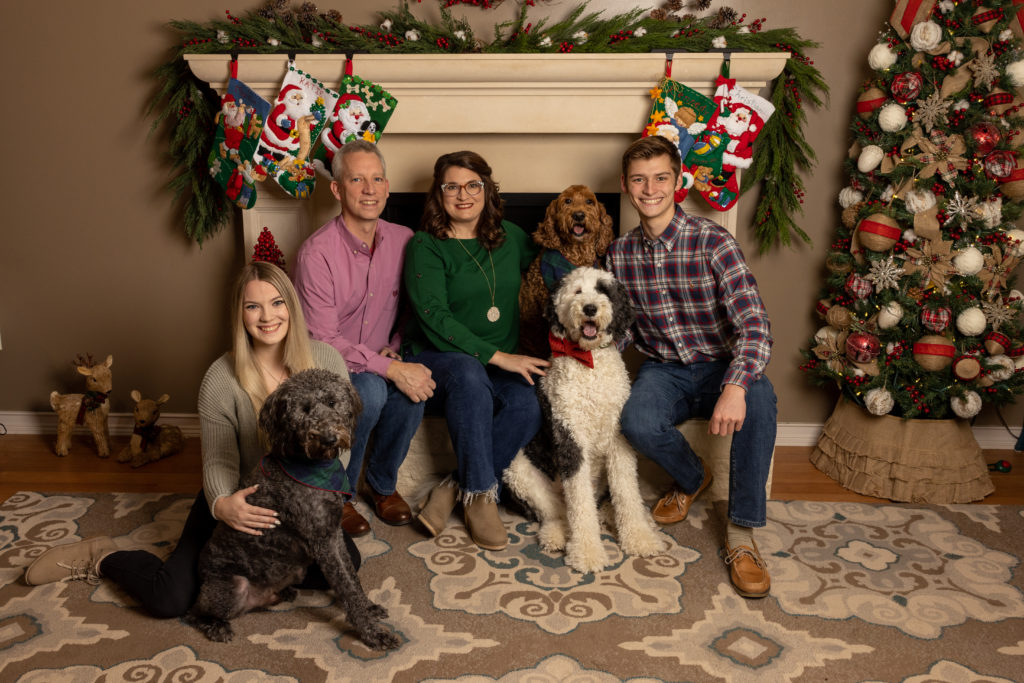
Elizabeth: Yes, and I love what you said about even though you were doing it for several years, and you knew so much, that there was more for you to learn, and I find that that’s true in this industry at large. There’s always so much to learn and I think we think sometimes, ‘Oh, we got it. You know, I’ve had dogs for decades. I know them.’ And it’s like, once you start learning, it’s like–
Katie: That’s how I met you! Because I had trained two of my own therapy dogs. I trained Molly myself. I got her at four months from the Humane Society, which was the best way to get a dog ever. She was kennel trained, leash trained, and could sit when I got her. [Laughs] It was fabulous. She had been being fostered by a wonderful family that taught her all of those things before she came to me. I got Scully as a younger puppy, so we had to teach him all of those things. So there’s a learning curve with that, but having raised and trained both Molly and Scully, after Molly passed, we got Harry, and you’ve met Harry. But we got Harry and I had been warned that sometimes this breed, not all the time obviously as we talked about, but can be stubborn. And I thought, I know what I’m doing. I’ve taken the canine body language class. I’ve trained two therapy dogs myself. I’ve had a career volunteering in my community with them. I know what I’m doing. And I got Harry and was so humbled by what I did not know. [Laughs] I need professional help here with Harry, and that’s how we met because I called you up and was like, ‘I need some help.’ And I have appreciated that with him and it’s important to learn and to continue to educate yourself, but it’s also important when you’ve reached that line where you know you don’t know and to reach to professionals like you for help.
Elizabeth: Absolutely. And I remember having Harry in class, and his signs are so subtle, like it’s just–he just does the slightest little movement. It’s like, ‘Oh you’re not comfortable. Oh, you don’t want to do that. How can we work with you in those moments when you’re not sure you don’t want to?’ And he likes to work. He needs a very specific setting sometimes to be able to be comfortable enough to do things.
Katie: Yeah, so I’m not sure Harry will–if he’ll ever be a therapy animal. He might be. He might not be. What I do know at this point, unless there was a huge shift in his personality or his comfort level, Harry would be amazing at one-on-one visits, very calm, what we call ‘predictable’ with Pet Partner visits. Something that’s only a couple people in a non-loud, low distraction environment. Harry’s never going to walk into a classroom, I don’t think, of kindergarten-age kids and let them all approach him. That’s going to create a lot of fear for Harry. But he–we joke at our house that his love language is touch. After he has a minute or two with a person, he is loving and caring and seeks out that interaction. That’s so important for a therapy animal to have and to enjoy. But it does take working with him and knowing what his fears are and helping him work through that and give him the reassurance that I know what I’m doing on my end of the leash too, and that I’ll listen to him when he talks to me through his language, when he gives those subtle cues that I notice and I respect that from him.
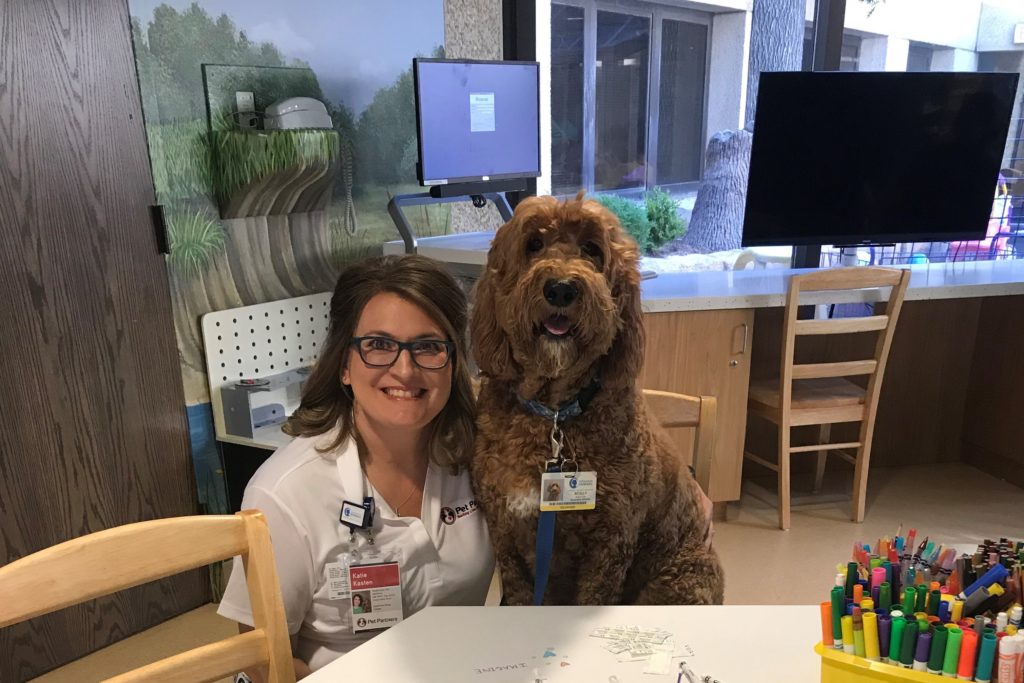
Elizabeth: Absolutely. Yeah, I don’t think I touched him once, because he’s like, ‘No, I’m good.’ [Laughs] I was like, ‘Okay, I’ll just hang out over here, buddy.’
Katie: He’s like, ‘No I’m fine, thank you.’
Elizabeth: Yeah, once he felt comfortable, it was really fun to watch him blossom. Well, Katie, how did you first get involved with Pet Partners?
Katie: Yeah, so this kind of crosses a couple different topics that we’ve already discussed, but we had just Molly at the time and my daughter was in middle school. She’s now a junior in college. So this was way back. We’ve both grown since then and she was looking to do some service hours for an organization she was involved in that required them to have a certain amount of service hours in their community and we had been told several times just by people in passing we should look at doing therapy work with Molly. That she would be really good at it. I used to walk to school to pick my kids up and take Molly with me and she would greet everybody in the pickup line. It was one of her favorite activities to do and she was just very social and very kind. And so, for that, her and I looked into it and Pet Partners actually registers handlers age 10 and up and so between the ages of 10 and 16, you have to have an adult or someone over the age of 18 with you on visits and with the handlers’ class, but for evaluating, she still had to go in the room with Molly by herself and evaluate. I was not present in the room for her evaluation and so she took the handler’s class. She and I did together, and both registered with Molly first and then with Scully. We got him while we were sort of going through the process, and he was a younger puppy and so dogs or animals have to be a year old to register with Pet Partners. We want to get them fully vaccinated and through that puppy stage to where they’re more reliable and directable in situations, but it took about two years until she registered with Scully. So that’s how we got involved was first looking at it that way. And we picked Pet Partners because a lot of the local hospitals here require Pet Partner certification for all the reasons we’ve talked about. We register or we have to evaluate every two years so, as you see, I’m sure, animals change over time and well, young animals act a certain way sometimes as they get older what they enjoy and what they want to do changes, just like their experiences and we as people change over time. We re-evaluate every two years and then our insurance coverage as well is usually some pretty big factors. So we chose Pet Partners for those reasons and to visit locally at some of the hospitals.
Elizabeth: So you started as a volunteer, and now you’re staff. How did that transition happen?
Katie: Yeah. I feel so blessed that that has occurred. I had a career earlier in life where I did statistics and project management, so almost different than what I’m doing now in the nonprofit world. And when my kids were younger, I started staying home with them for a while, so I did not work and concentrated on my kids and some home improvements and spending time with my animals. And when my youngest was about ready to drive, we talked about as a family, me starting to work again. I just got really lucky that Pet Partners started hiring some staff remotely. Our headquarters are based in Bellevue, Washington, which is near Seattle. And some of the positions we do have remote staff for. More so now with Covid, because everybody has remote staff now nearly, right. The year before that became a gigantic thing that Pet Partners started to expand, and they realized when they were starting to allow people, realizing everybody didn’t need to be in Bellevue, that they had this vast network of volunteers that were already passionate about Pet Partners. They were already knowledgeable about Pet Partners, that already had a ton of skills that would be great for working directly with Pet Partners as staff. So, they put the announcement out first to their group of volunteers, which I was a part of and I saw it and applied, and so I just feel really blessed to have found a second career or however you want to phrase it–a second job–getting paid to help an organization that I was already working with for free as a volunteer.
Elizabeth: It’s so wonderful when things connect like that, where it’s like, what you love to do, what you’re skilled at, what you want to continue doing and to be able to make a living is really wonderful.
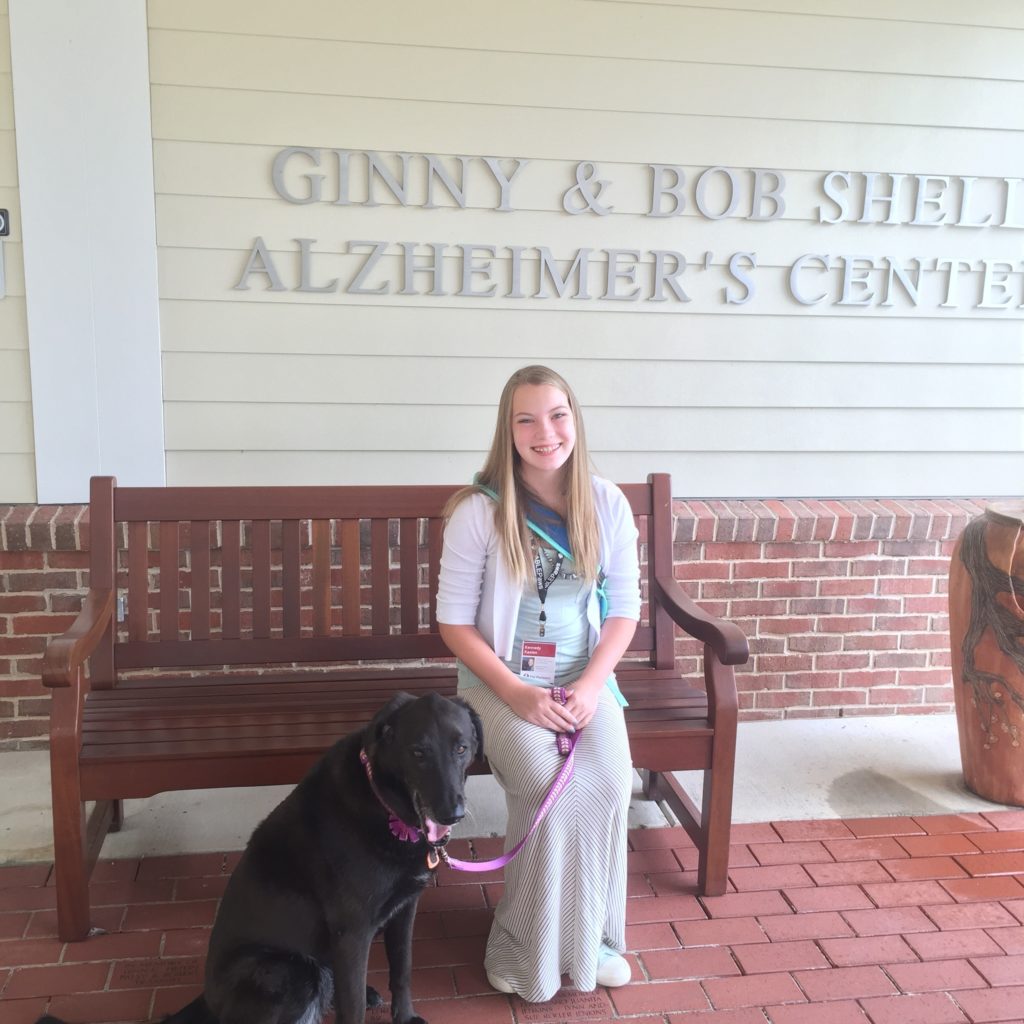
Katie: Yeah. It just is very much a blessing for us.
Elizabeth: Well, Katie, what should people know about getting registered and how they can prepare for that process?
Katie: I think the biggest thing is socialization, and seeing if your animal likes to be in those environments. It’s one of those things where therapy teams inevitably, just like with Molly, she got older and we stopped visiting probably a year or two before she passed. Just as she was older that wasn’t something that was real accessible for her anymore. And so, we’ll have teams that will want another animal when they get to that age to register to keep doing this type of therapy work. It doesn’t always happen that the animal that you get as they grow and change and develop turns out to be one that is good with therapy work, because not all people are good at it, not all animals are good at it. So it’s a good question. I think socialization. Taking them out every place you can when they’re younger. I know when I was taking Scully out as a puppy, before he turned one and we tested. We went into Lowe’s one time without him and the lady checking us out at Lowe’s asked me where Scully was by my name. And my husband was like, ‘How many times have you been in Lowe’s with the dog?’ I was like, ‘Well, a couple times a week for a couple months.’ I wouldn’t go to lunch with friends unless they’d agree to sit on a patio and let me take my dog with me. There are a lot of dog-friendly places you can take your animal out to socialize them. Old Navy, Lowe’s, Home Depot, Bass Pro Shop. I just would take him everywhere that I really could to get him out and socialize. And then, classes like yours that you do. Ones that help teach some of the basic skills that they need for obedience: come, sit, stay, come when called. While It is not a requirement and we do not test on it, kennel training I think is really important, even if your animal, you don’t intend to keep them in a kennel in your home, it’s always important that they have that skill and that they are comfortable. In cases of emergency or when we go on visits. Occasionally you may have to leave your animal, but you can’t just leave your animal. When you go out as a team, you have to have a leash or lead on your animal at all times. So if for some reason you had to being able to put them in a kennel for their safety, when you need to leave them, is important as well.
Elizabeth: Yeah, and I just want to add on there, too, it’s okay with socialization to go slowly at the dog’s pace and make sure that they’re–it’s easy to think of like safe, secure situations so instead of thinking like, ‘I gotta go to Lowe’s fifteen times this week to get my dog socialized,’ maybe try once to see how it goes. Gently is just as effective, too.
Katie: Oh, I found that so important with Harry. We actually started going out in public with a vest that said ‘do not pet’ on. And, well, I hope that one day he’ll be able to greet people at large. We are not there yet for him. He does not want masses of people to greet him. So we started going out in public, and Lowe’s probably will get mad if I keep mentioning them. They’ll end up with all these dogs in there. [Laughs] But I would put a ‘do not pet’ vest on him, take my treat pouch with me, and we’d go on Friday nights like an hour before they close, because that is the least populated time in Lowe’s, is 8:30 on a Friday night. And we would literally walk in, walk up and down two aisles, and back out, is how we started and because–and you’ve met him–that’s what Harry needed–is to get comfortable going in and out. And we have now gone to an ‘in training’ vest and so people aren’t sure whether they should approach them or not. But if they do, they ask. Hopefully we’ll get to the point where he can wear a ‘pet me’, or ‘please ask to pet’ type thing, but right now he’s in an ‘in training’ and we have greeted a few people on very limited basis and I keep most of his visits still to 10 or 15 minutes.
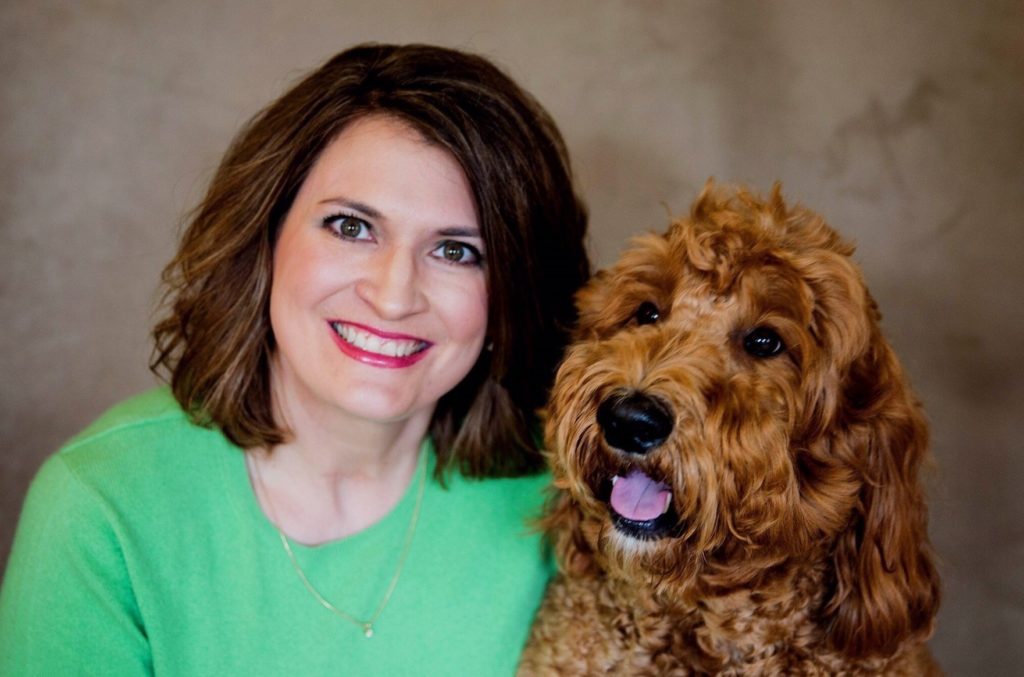
Elizabeth: I love that. Yeah. I just I think it’s so wonderful and it shows him that he’s in safe hands with you. He can trust you. You’re not going to put him in a situation where he’s uncomfortable. He doesn’t need to do certain things and he’d rather not and that’s okay, so I really love that, and that’s just gonna keep developing your relationship with him, too.
Katie: Yeah and when you said right there, that was kind of key for our Pet Partners teams, and what we look for, that he knows that he’s safe with me, and it’s that relationship between the human and the animal, that human-animal bond, that is so important, both we feel as registering teams that they know their animal, that the animal knows them, that there is mutual respect and safety between the handler and the animal and that’s why we evaluate the way we do. But also, we rely on that human-animal bond when the animal is visiting with people. It’s sort of this bond that’s working in multiple different ways on therapy visits. Both between the handler and the animal, and between the animal and who they’re visiting. It’s really multifaceted and it’s important.
Elizabeth: I love that. So important to bring up. Well, Katie, how is Pet Partners going to celebrate on April 30? What can we look for?
Katie: Yeah. There are multiple events going across the country, so it matters where you are. And locally, there is actually a community Partner of Pet Partners teams. So it is a local organization of therapy teams that are working here in central Arkansas. They have not solidified their plans on April 30 yet, but are planning to do something and we’ll be posting updates on their Facebook page, which is Central Arkansas Pet Partners.
Elizabeth: Katie, I think that was all of my questions. Is there anything else that you’d like to add?
Katie: No. I want to thank you for this opportunity to talk about Pet Partners and also just share about what we do and my animals. And thank you for your help with Harry along the way, as well. We’ll see if he gets there, if that’s something he wants to do in the future.
Elizabeth: Yes. Yeah, it’s been such a delight to have all of you in class and to get to know you, and I know we’ve been talking about doing this episode for a while, so I’m glad it was timely and worked out. Well, Katie, where can people find you or how can they contact you?
Katie: Yeah, so always, you can go to petpartners.org. Don’t forget the ‘s’ on the end of partners. That can often get overlooked when you’re putting it in. But petpartners.org and that actually will lead you to if there’s any workshops coming up in central Arkansas or if there’s any activities going on. And a lot of information about whether if someone’s interested in doing this, there’s sort of like a little quiz to take if you and your animal would be good as a Pet Partner’s team. If you have an organization or facility and want to hear about it, feel free to reach out to me directly. I’d love to come talk to any group or organization that would like to hear about Pet Partners, and I can be reached directly at katiek@petpartners.org. So it’s k-a-t-i-e-k at Pet Partners dot org.
Central Arkansas Pet Partners Facebook Group: https://www.facebook.com/groups/579459839351675
Main Pet Partners Website: https://petpartners.org/
Katie’s Email: KatieK@PetPartners.Org
Pet Partners has a proclamation from Pulaski County proclaiming April 30 as National Therapy Animal Day. Look for events and celebrations locally.
Elizabeth: Perfect. And I’ll link that and everything else you mentioned in the description and the blog post as well. Well, Katie, it’s been truly wonderful chatting with you. Thank you so much for coming on. I’m gonna do the sign off and at the end, I have a question for you.
Katie: Okay.
Elizabeth: This has been Telltail Dog the Podcast with your host, Elizabeth Silverstein, certified dog trainer in central Arkansas, and my guest today, Katie Kasten. Music has been provided by Jim Ciago of Seven Second Chance. Find more of his work on iTunes and Spotify. And stick around after the music for some final advice from Katie.
[Music]
Elizabeth: Katie, before we sign off completely, what advice do you have for someone who wants to get started with their animal for therapy animal registration?
Katie: Yeah, I’d say to educate yourself. Do some internet research. Talk to some other people. I’d be willing to talk with you. Elizabeth, I know that you’re open to discussions about what animals may need for registering this way. And socialize your animal. Take them out. See if they are excited about this type of work. And get excited. There’s so many ways to volunteer here locally and there’s so many opportunities. We’d love to have you.

